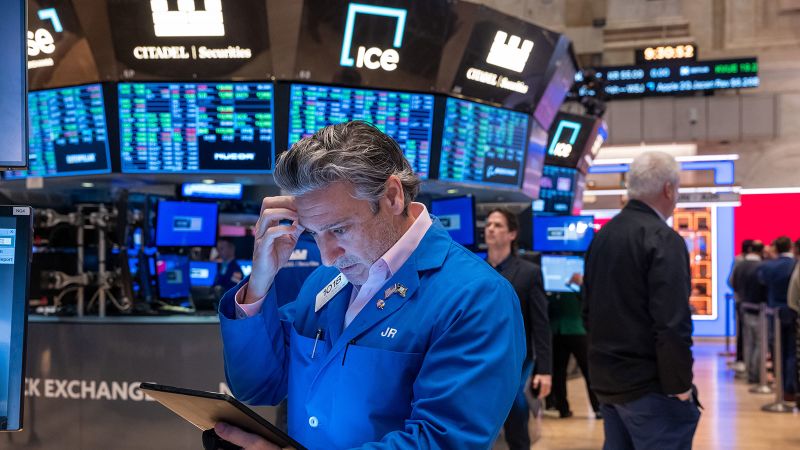A version of this story first appeared in CNN Business’ Before the Bell newsletter. Not a subscriber? You can sign up right here. You can listen to an audio version of the newsletter by clicking the same link.
New York
CNN
—
Investors are grappling with a painful reality check: The Federal Reserve is unlikely to slash interest rates anytime soon.
That, at least temporarily, stalled the gangbusters 2024 stock rally and lowered morale on Wall Street. Traders fear that elevated rates will uphold painfully high borrowing costs for consumers, squeeze corporate profit and weigh down the market.
The good news? History suggests that higher-for-longer rates don’t translate to painful losses for portfolios, even if there may not be much more upside near term for stocks.
The benchmark S&P 500 index has added roughly 13% on average during Fed pause periods, according to LPL Financial data compiled by CNN spanning about 35 years and six stretches when rates have been on hold. The S&P 500 has gained 14% during the current period, from when the Fed last hiked rates in July 2023 through Thursday’s close.
“Long pauses are typically good for stocks,” wrote Jeff Buchbinder, chief equity strategist at LPL Financial, in a Tuesday note. ”It’s when the Fed is forced to cut because of economic weakness that stocks tend to sell off — not in the environment we’re in today.”
The US economy has stayed remarkably resilient, even after the Fed began an aggressive battle against wayward inflation that brought rates to their highest level in decades. The labor market has stayed strong, consumers have continued spending and stocks have notched repeated record highs.
That economic resilience, coupled with months of data showing sticky inflation, even raised concerns that the Fed would raise rates again. Chair Jerome Powell earlier this month quelled those fears but warned that the central bank needs to see inflation come down further before easing policy.
“So far this year, the data have not given us that greater confidence. In particular, as I noted earlier, readings on inflation have come in above expectations,” Powell said at the Federal Open Market Committee’s post-meeting press conference.
Some economists say that the central bank, which has penciled in three rate cuts for 2024, is still on track to cut rates at least once or twice this year. Traders expect the Fed will begin easing rates in the fall, according to the CME FedWatch Tool.
The April jobs report was a welcome sign that the labor market is cooling without cratering. The labor market added just 175,000 positions last month, marking its lowest tally since October 2023 and a sharp cooldown from the upwardly revised 315,000 jobs added in March. April’s job gains are in line with pre-pandemic levels and the neutral rate of job growth needed to pace with population growth.
First-time applications for unemployment benefits climbed last week to 231,000, the highest level since last August, in another sign that the labor market is cooling.
Annual wage gains, a potential inflation booster watched closely by the Fed, are at their lowest level since May 2021. The slowdown in both wage gain and payroll growth last month is supportive of hopes that the Fed can tamp down inflation without triggering a recession, according to some investors.
“The case for rate cuts got a little stronger,” wrote David Russell, global head of market strategy at TradeStation, in a note earlier this month. “Goldilocks could be making a comeback.”
The US federal government is teaming up with Wall Street in a new cybersecurity alliance aimed at defending the financial system from a nightmare attack and deterring hackers from even trying, according to a letter sent to bank CEOs by a senior Treasury official and viewed by CNN.
The new public-private partnership, dubbed Project Fortress, underscores the real danger US officials and bank executives believe cyberattacks pose to the economy, reports my colleague Matt Egan.
“The message to bad actors who want to use cyberspace to go after US financial institutions is: We are watching, we are protecting the system and we will come after you if you go after the US financial system,” a US official told CNN.
Project Fortress includes protective measures such as a new cyber hygiene tool that automatically scans companies for vulnerabilities and a new automated threat feed, according to the letter, which was sent to bank trade groups earlier this week.
But Project Fortress is not just about playing defense.
Deputy Treasury Secretary Wally Adeyemo said in the letter that the alliance also includes “offensive actions” that employ Treasury’s national security tools as well as US law enforcement to “make clear to our adversaries that they will face consequences for their attacks.”
Those national security tools include deploying Treasury’s sanctions team, a person familiar with the matter told CNN.
Two of the planet’s richest businessmen are becoming embroiled in India’s increasingly divisive election campaign, reports my colleague Diksha Madhok.
The world’s most populous nation is in the midst of a mammoth election in which Prime Minister Narendra Modi is widely expected to secure a rare third consecutive term.
Modi is running on his economic record over the past 10 years, a period of robust growth for India, as well as for its two most famous billionaires: Mukesh Ambani and Gautam Adani.
Likened to the industrialists who helped build America’s “Gilded Age,” both men are considered vocal champions of Modi and their perceived closeness has been the subject of intense criticism by rival politicians.
But at an election rally on Wednesday, Modi appeared to accuse his primary political opponent of accepting money from Ambani, chairman of India’s most valuable private company Reliance Industries, and Gautam Adani, the founder of ports-to-energy conglomerate the Adani Group.
“Why has Shahzade Ji stopped talking of Ambani and Adani in this election all of sudden? People are smelling a secret deal,” Modi said on X, where he posted a video of his speech. Shahzade, or prince, is a widely understood reference to Rahul Gandhi, the longtime face of main opposition party Indian National Congress.
“How much money have you taken from Ambani and Adani?” he said at the rally.











